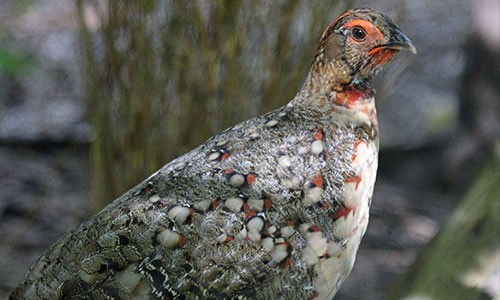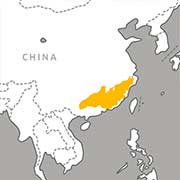Cabot’s Tragopan
Tragopan caboti

About the Cabot’s Tragopan

Geographic Range:

Class: Aves
Order: Galliformes
Family: Phasianidae
Genus: Tragopan
Species: caboti
This Asian relative of partridges and pheasants shares its native habitat in the hills and mountains of southeast China with the red panda. Tragopans don't migrate. Instead, they overwinter in their home range, sometimes gathering in small flocks made up of several pairs of birds.
Cabot’s Tragopan Facts
Appearance:
The male Cabot's tragopan has a dull golden breast and a black, brown and white speckled back. In contrast, the female is a rich brown with small white speckles. The male's head is a brilliant scarlet on black, with a bright blue "lappet" (a flat overhanging or hanging piece) on the throat. Thick, insulating layers of feathers protect the Cabot's tragopan by keeping out cold and moisture. This is important since the forests they inhabit are very rainy and often at high elevations.
Size:
Weight: Females average 2 pounds and males 3 pounds
Length: Females average 20 inches and males 24 inches
Diet:
Herbivorous, these birds eat flowers, seeds and fruit.
Reproduction:
They breed between March and May, laying 2-6 eggs in a nest which may be in a tree or on the ground. After a 28-day incubation period, females and the young remain in the nest for 3 days before foraging. They remain together until the end of the following winter.
Behavior:
Males display a very flamboyant mating ritual, inflating their blue lappet and spreading their wings to attract females and demonstrate their health and vigor. Multiple family groups will sometimes live together over the winter, including males.
Role in their habitat:
They are prey for wild cats and foxes, while their eggs can be eaten by rodents and shrews.
Habitat/Range:
Living primarily near rivers and streams, the Cabot's tragopan is endemic to evergreen forests in southern China.
Median Life Expectancy:
15-18 years
You Can Find This Animal in the Children's Zoo
You Can Help!
Cabot’s tragopans are vulnerable mostly due to the destruction of their forests for logging and farming. You can help by looking for the Forest Stewardship Council logo on all of your paper products before you buy them.

You might also like
At Franklin Park Zoo:
At Stone Zoo:

